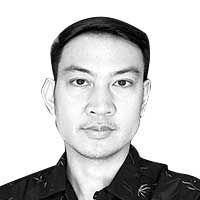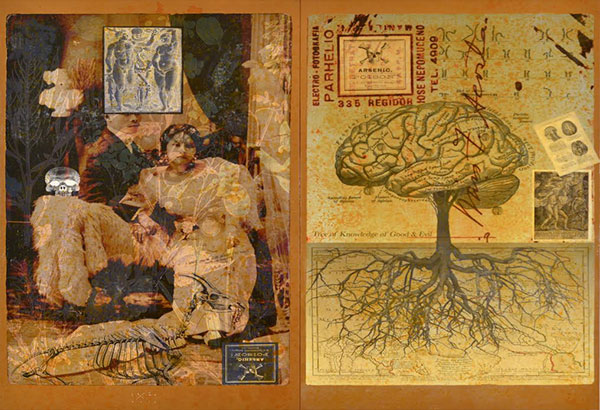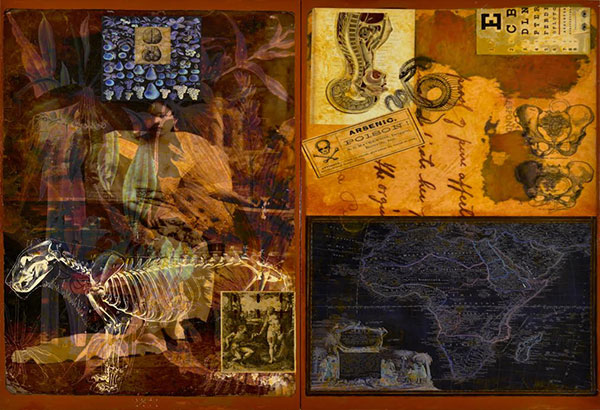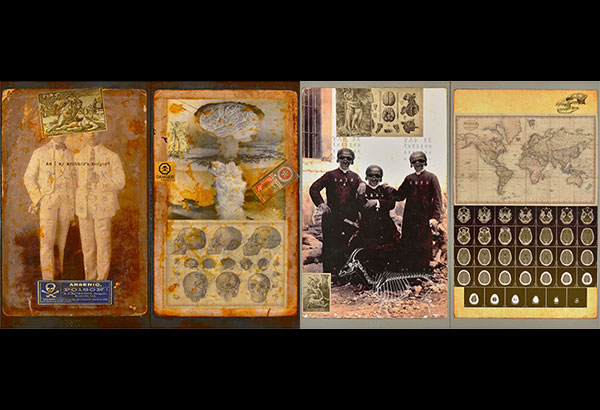Antonio Leaño’s search for origins


“Tree of Knowledge of Good & Evil” and “Fruit of Knowledge of Good & Evil” by Tony Leaño
Few artists would brazenly claim that their works are an attempt to grapple with the eternal questions concerning man’s origin and destination, but Antonio “Tony” Leaño, in his recent exhibition “East of Eden” at the Pinto Art Museum, configures the inquiry as a suite of powerful, large-scale works, translating scientific, religious, philosophical and mythical references into visual allegories suitable for the distracted, multitasking times. The result: a multi-layered map; a generative system of signs; a palimpsest of text, images, gestural interventions and illustrations waiting to be deciphered.

He calls his works “electronic collage” or “digital collage” in which the elements of the works are stitched together, or superimposed against or placed on top of each other. A dab of abstract strokes renders the artist’s bodily touch. Some of these are diptychs which, because of the juxtaposition of dissimilar images, become all the more pregnant with meaning. “I’m really process-oriented: layering, collage, print,” Tony said. “Before, wala pa akong nakikitang nagsi-silkcreen printing on top of a painting, ako I was already doing it — serigraphy.”
Upon closer inspection, the works reveal a kind of industrial sheen, which is brought about by the clear acrylic topcoat to “protect it and make the image sharper.” Partly, this is the result of his observation at Pinto Art Museum where guests become all too eager to engage with the artworks. “They take selfies, they touch it, they lean on them,” he said. The acrylic makes the works resistant to dust, water and certain chemicals.
The base image of the works is an appropriation of a Filipiniana photograph — a solo or group portrait — from the turn of the century to the American period. Garbed in the fashions of the times, the subjects assume formal poses, their open, unquestioning gaze forever conveyed by the camera.
While the photographs have assumed the purpose of historical documentation and are mostly in sepia, “it’s not about a sense of nostalgia.” For Tony, the figures are stand-ins for any human, “since we are all genetically connected to the source. There’s no difference if I represent a contemporary picture, tayo lang naman din ’yun eh. We’re connected through our DNA. We’re one and the same.”
According to the artist, this notion of sameness is traceable to Adam and Eve, the metaphorical first humans. Scientific forays have determined an area that extends from Middle East all the way down to Africa that may hold the probable clue as to the birthplace of humanity, and this for Tony is nothing but the East of Eden, which is “a location, a geography, a coordinate.” Hence, we see maps tracing the paths of migration originating from Mesopotamia, Armenia and South Africa incorporated into the works.

“Am I My Brother’s Keeper?” and “Y Chromosomes”
For Tony, understanding ourselves and others entails not digging deep into the recesses of the ever-fugitive soul but into the cellular level, the DNA. For instance, a woman’s head in the works may seem to be haloed by a line but it is actually the genetic illustration of the mitochondrial cells. And with evil still occurring in so many different parts of the world, the artist considers Cain as the source of man’s negative compulsions, which have been carried and passed down from one generation to another through gene memory.
Surely, the works in the exhibition are not literal translations of different ideas with regard to man’s origins, but conflations, negotiations, contradictions. They assume the stance of bold theories, such as the proliferation of the anatomical brain in the works to signify the fruit of the Tree of Good and Evil. “The only thing in this world that can discern good and evil is the brain,” Tony argued.
Hence, “East of Eden” may be seen as the artist’s coded message to the world, ready to be deciphered by the curious viewer through highly charged and relational symbolism that feeds from and into the various rivers of human knowledge. So long as Tony, who is currently working on a show that will open at the Ayala Museum on March 23 next year, is besieged with questions, he will continue to paint, his way of “understanding the world, my existence here.”
* * *
For more information on Antonio “Tony” Leaño’s works, contact Pinto Art Museum at 697-1015 or email pintoartmuseum@yahoo.com.



















